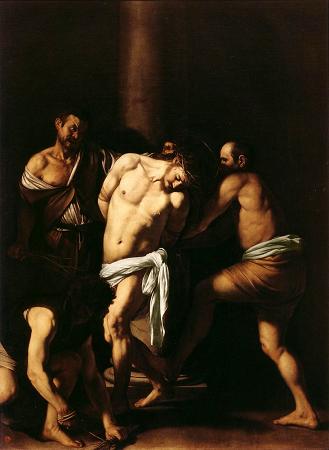
Flagellation. The Flagellation of Christ is a painting by the Italian Baroque painter Caravaggio, now in the Museo Nazionale di Capodimonte, Naples.
It is dated to 1607, and may have been reworked by the artist in 1610. It is not to be confused with Christ at the Column, another Flagellation by Caravaggio of the same period.
According to art biographer Gian Pietro Bellori, this work was commissioned by the di Franco family for a chapel in the church of San Domenico Maggiore in Naples. The family were connected with the Confraternity of the Pio Monte della Misericordia, for whose church Caravaggio had already painted The Seven Works of Mercy.
It was moved to the museum at Capodimonte in 1972. The Flagellation of Christ had long been a popular subject in religious art, and in contemporary religious practice, where the church encouraged self-flagellation as a means by which the faithful might enter into the suffering of Christ.
Caravaggio would have had in mind the famous fresco by Sebastiano del Piombo in the church of San Pietro in Montorio in Rome. Caravaggio has reworked Piombo's composition by drastically reducing the picture space so that the sculptural figures seem presented on a shallow stage. He has, however, retained Piombo's sense of the flagellation as a kind of sadistic ballet, with the figures arranged rhythmically across the canvas. Caravaggio's painting introduces an acutely obs
It is dated to 1607, and may have been reworked by the artist in 1610. It is not to be confused with Christ at the Column, another Flagellation by Caravaggio of the same period.
According to art biographer Gian Pietro Bellori, this work was commissioned by the di Franco family for a chapel in the church of San Domenico Maggiore in Naples. The family were connected with the Confraternity of the Pio Monte della Misericordia, for whose church Caravaggio had already painted The Seven Works of Mercy.
It was moved to the museum at Capodimonte in 1972. The Flagellation of Christ had long been a popular subject in religious art, and in contemporary religious practice, where the church encouraged self-flagellation as a means by which the faithful might enter into the suffering of Christ.
Caravaggio would have had in mind the famous fresco by Sebastiano del Piombo in the church of San Pietro in Montorio in Rome. Caravaggio has reworked Piombo's composition by drastically reducing the picture space so that the sculptural figures seem presented on a shallow stage. He has, however, retained Piombo's sense of the flagellation as a kind of sadistic ballet, with the figures arranged rhythmically across the canvas. Caravaggio's painting introduces an acutely obs
Wikipedia ...